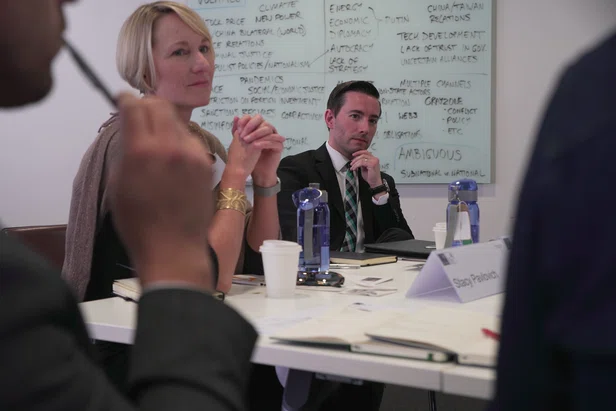
Close
result
FEATURED ARTICLE
When cultures collide
When cultures collide
Jon Heit
8 min read

Emotions run high during mergers and acquisitions. Jon Heit reflects on his own experience to identify the unique role that the chief of staff can play in facilitating a successful integration.
The process of a merger or acquisition is made up of different phases. There is the initial buzz and excitement. Then there is the pressure and push through due diligence, a time when the acquired workforce is acutely aware of the uncertainty ahead. What will happen to their roles, their status, their jobs? For large deals requiring government approval, there is a mad dash once the companies receive the green light from the authorities – a scramble of signatures, disclosures, announcements, and press because the deal has now been ‘closed’.
Then the journalists and the lawyers move on to something else. But for the people in the two companies that have just merged, this is when the next phase starts and the real work begins.
Google acquired the cybersecurity firm Mandiant in September 2022 for $5.4 billion. To date, it is the second largest acquisition in Google history. The strategic logic behind the deal was clear and straightforward: buy one of the best brands in cybersecurity to help build the world’s most secure cloud.
At the time, I was chief of staff to Mandiant’s Chief Product Officer. Our teams across product and engineering were highly involved in the due diligence process and I did what any CoS does in times of pressure and chaos: lessen the chaos and get the trains running. While the process was involved and complex, the real challenge came later when we faced the task of combining two companies in the pursuit of a powerful corporate vision.
Connective tissue, translator
Connective tissue, translator
The strategic nature of the acquisition created genuine excitement. Mandiant’s culture is strongly ‘mission driven’. ‘We respond to the breaches that matter’' was a common refrain of the CEO, Kevin Mandia (Kevin has stepped down). So the mission to build the world’s most secure cloud resonated strongly.
Still, everything from employees’ laptops to team calendars, to vendor contracts, to job titles, had to change. The sweeping change affected the processes of the business that create the texture of people’s daily rhythm. Such disruptions bring out the deep influence of a company's culture. And this was where my role as an operator receded and the other side of being a chief of staff took priority: serving as the connective tissue across teams and organisations.
Google has a strong engineering culture that prioritises the input of the frontline employees. Brilliant engineers are the heroes and teams strive to include as many perspectives as possible when making decisions. That, in part, is how you end up with a culture that could create Gmail, an engineer’s side project that was born of annoyance with how email worked. An engineer may put on their team’s hoodie (likely their ‘nice hoodie’) to show pride in their creation. Mandiant employees were excited and intrigued to be part of this new-to-them culture.
At the same time, the Mandiant hero is the incident responder or the intelligence professional who does not hesitate to help a customer in crisis. They calmly guide a CEO and their board through deep moments of crisis while dealing with the threat of criminals demanding multimillion dollar ransoms. It's a disciplined organisation. People understand a chain of command and how to respond quickly during a crisis, even when it gets messy.
Everyone knew these differences existed and understood that integrating established cultures is inherently challenging. But we also knew there was great potential. The empowerment and innovation of Google mixed with Mandiant’s mission drive would be a formidable combination. What we didn’t know – but soon found out – was how much work it would require to integrate the cultures in the day-to-day life and rhythm of business.
How teams make decisions or regard a chain of command affect countless things in the course of a day. While there was excitement and genuine desire to merge the cultures, subtle cultural differences crept up. For instance, Mandiant people often did not use the ‘raise your hand’ function in a meeting. Everyone seemed to speak over one another, though the chain of command was obvious to the participants. This could seem rude or chaotic to Googlers who tended to raise their hands in video calls, taking turns politely. And, naturally, they did it using Google Video Chat – Mandiant had used Microsoft products for meetings and communications for years. Inevitably, a Googler would dazzle with some feature in Docs or Sheets while someone like me could get frustrated when we could not recreate the feature or capability.
These were small cultural tendencies that could add friction to the rhythm of business, not clashes. As the teams spent more time together, they would learn these nuances and adapt. But it was in the earliest weeks of the integration that they were most noticeable, and it was during this time that being able to translate between the cultures was most valuable.

Finding your mirror image
Finding your mirror image
By far the most important decision I made during this entire journey was to find my corresponding equivalent of the chief of staff, and quickly build a relationship. I found her quickly. She did not in fact have the chief of staff title, but she had the profile and the personality. She was a super-connector, someone who always knew what was going on, how the place worked, the politics, the processes, the people – the mores and unspoken sins and virtues of the place.
We met early on and several months before the deal closed; we knew that we needed to have a good relationship. When the time came to integrate the two organisations we not only knew each other well, but we trusted each other. We had worked out where the landmines were likely to be.
We could help each other translate our company’s dialect. At Mandiant, we used ‘intelligence’ or ‘intel’ in at least five distinct ways. So while my teams might feel insecure about not being able to make some drop-down feature work, my new colleagues were getting lost in conversations about ‘intel’.
When change is happening fast and at scale, people often feel unsettled. We could help – sometimes even completely nip something in the bud just by explaining the differences to each other and then to everyone else. I could explain the different meanings of ‘intel’ by context; she showed me all those cool features in Docs or Sheets we couldn't figure out. It turned out they were new software features being tested by Googlers before their public release.
We made ourselves available to our teams and each other’s teams. We made sure everybody knew that they could talk to us. In fact, we went out of our way to find people and just check in – ‘How are you doing? How's your team? How are you feeling?’ We particularly looked for the people who were most excited, so that we could champion and amplify their work.
As a chief of staff (and de facto CoS for my counterpart), we had the freedom of movement to insert ourselves into conversations or just to reach out to people without raising anyone’s defences. That meant that we could encourage and connect the people who most wanted to cross organisational boundaries and engage with those ‘on the other side’. Showing others what could be done and what was learned got more people involved.
As chiefs of staff we were viewed as distinct from the management chain, and were therefore more approachable. We could have different, candid conversations up and down the chains of command, and sideways too, without distorting power dynamics. Being that honest broker and ‘safe space’ person was, I think, critical to our success.
Diffusing the rumour mill
Diffusing the rumour mill
One of my executives introduced a powerful intervention during this period that was simple but brilliant. During the usual management meetings or all-staff meetings, he started to leave time at the end of the official agenda to ask, ‘Questions, comments, concerns... rumours?’, followed by an impish grin.
The first time he did it, everyone laughed nervously and no one said anything. But he kept doing it, and then we started doing it in other group settings. We kept asking what rumours people had heard. This created a safe space for people to voice insecurities regardless of their origin. They might say, ‘I'm not complaining myself, but I have heard that some of my team get really frustrated by how process-heavy things are, and how we always refer everything to the lawyers.’ Or ‘I know it seems silly, but some people just don’t understand how the others create that function in their spreadsheets and it makes every meeting feel a little bit sour because they feel stupid.’
It was such a simple intervention but it became a safety valve, a way to let off steam and air issues. It also provided vital intelligence for me and my mirror image about where culture clashes were occurring and where we needed to step in to help translate or smooth ruffled feathers.
Understanding and aligning
Understanding and aligning
Assimilating and integrating after a merger or acquisition is an enormous operational and strategic challenge. It is also – and perhaps foremost – an emotional process. In the early months in particular, anxiety and excitement run high, at times giving way to fear. Even when people are not worried about losing their jobs, they worry about how their jobs will change, about how to adapt to new ways of working, and whether they will be able to fit in and succeed.
An effective chief of staff not only can help ease the operational chaos and challenges of an acquisition. They have the freedom of manoeuvre to make connections across and between organisations. They can translate and bring clarity to cultural confusion, and thereby drive alignment. Such efforts are easy to underestimate, but they are invaluable contributions to the success of any acquisition.
This month we celebrated the two year anniversary of the acquisition. Google Cloud’s security business has grown exponentially. The unique expertise of Mandiant and the planet scale products of Google work together to reshape security. We can give our customers the advantage as they defend themselves against ever changing cybersecurity threats.

Author Bio
Jon Heit
Strategy & Operations, Cloud Security @ Google Cloud
jonheit@google.com
Jon Heit is responsible for Strategy & Operations, Cloud Security @ Google Cloud. He was the Chief of Staff to the Chief Product Officer at Mandiant from 2020 until 2022 when Mandiant, one of the world’s foremost cybersecurity companies, was acquired by Google Cloud.
Previously, Jon led Product Management for Mandiant Threat Intelligence and served in the United States federal government. He holds bachelor degrees in Political Science and Religious Studies from Santa Clara University, and a Masters from Harvard University.








